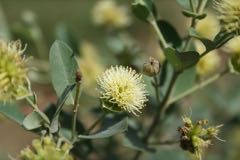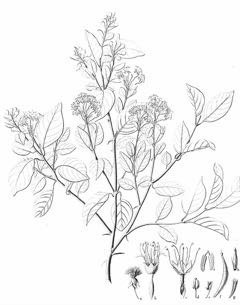 |
|
Marco Schmidt wikimedia.org |
 |
| http://www.edibleplants.org |
Translate this page:
Summary
Guiera senegalensis is an evergreen flowering shrub usually growing 1 - 3 m in height commonly found in tropical Africa. The bark is gray. The branches are softly hairy. The flowers are yellowish green and are in round heads. The leaves are gray-green and oval. The leaves are known as a ?cure-all? and used for the treatment of a wide range of conditions. The twigs are chewed for symptomatic relief of scorpion stings. The roots can be powdered and/or boiled and used for relief from diarrhea and dysentery. The fruits are used for hiccups. The plant is a source of 3,4,5-Tri-O-galloylquinic acid, a hydrolysable tannin classified as a natural product with anti-HIV activity and a DNA polymerase inhibitor. Also, the plant is a pioneer species and is often found growing on very poor and degraded land. The bark produces gum. The thin branches are used for baskets and mats. The roots are used asa chew sticks and toothpicks. The smoke from burning branches repel flies. The wood is commonly used for the framework of wells, bed post, etc.
Physical Characteristics

 Guiera senegalensis is an evergreen Shrub growing to 2.5 m (8ft) by 2.5 m (8ft) at a slow rate.
Guiera senegalensis is an evergreen Shrub growing to 2.5 m (8ft) by 2.5 m (8ft) at a slow rate.
See above for USDA hardiness. It is hardy to UK zone 10.
Suitable for: light (sandy) and medium (loamy) soils, prefers well-drained soil and can grow in nutritionally poor soil. Suitable pH: mildly acid, neutral and basic (mildly alkaline) soils. It cannot grow in the shade. It prefers dry or moist soil and can tolerate drought.
UK Hardiness Map
US Hardiness Map
Synonyms
Guiera glandulosa Sm.
Plant Habitats
Edible Uses
Edible Parts:
Edible Uses: Gum
The leaves are also used to curdle milk.
References More on Edible Uses
Medicinal Uses
Plants For A Future can not take any responsibility for any adverse effects from the use of plants. Always seek advice from a professional before using a plant medicinally.
Antidiarrhoeal Antiinflammatory Antirheumatic Antiseptic Antitussive Appetizer Blood purifier Diuretic
Dysentery Febrifuge Galactogogue Hypotensive Laxative Leprosy Pectoral
Poultice Skin Tonic Vulnerary
The leaves have a high reputation as a 'cure-all' in Africa, where they are used in the treatment of a wide range of conditions. They are most commonly taken in decoctions or are mixed with foods[332 ]. The bitter tasting leaves are antitussive, appetizer, blood purifier, diuretic, febrifuge, galactagogue, laxative, pectoral and tonic[332 ]. They are used to treat a wide range of conditions such as: pulmonary and respiratory complaints, including coughs and fevers; digestive tract problems including colic, dysentery and diarrhoea; infectious diseases including syphilis, beriberi and leprosy; and various other conditions such as impotence, rheumatism and oedema[332 ]. The powdered leaves are mixed with food as a general tonic and blood restorative after any exhausting condition, and especially given to women after childbirth to promote the flow of milk[332 ]. The leaves are commonly made into an infusion, combined with those of Combretum micranthum, for treating fever, chest and rheumatic conditions, and as a nasal douche for cold in the head[332'. Combined with tamarind pulp, the leaves are held to be a good laxative and appetizer[332 ]. The plant has a special reputation as a preventive of leprosy and many people drink a cold decoction of the leaves every morning and evening; in particular it is given to the newborn child, and to the child of a leper parent, or when there is the least suspicion of hereditary taint or early symptoms[332 ]. The dried leaves are smoked in a pipe and the smoke is blown through the nose as a remedy for colds[332 ]. They are mixed with tobacco for smoking as a treatment for coughs and respiratory trouble[332 ]. The powdered leaves are added to a snuff taken for headache and sinusitis[332 ]. The leaves are applied externally to bring healing to the body - they are considered antiseptic and vulnerary. They are applied to wounds, sores in the mouth, syphilitic chancres and phagadenic ulcers[332 ]. The leaves are applied to skin infections and in poultices on inflammatory swellings and for guinea-worm; they have been applied to tumours to maturate them and as a treatment for skin-diseases[332 ]. A leaf-decoction is used as a body-wash and for bathing new-born babies[332 ]. The fruit and leaves are common ingredients in more or less ceremonial prescriptions for strengthening and preventing disease in young children[332 ]. The twigs are chewed for symptomatic relief of scorpion stings[332 ]. The powdered and boiled roots are considered a remedy for diarrhoea and dysentery[332 ]. The fruits, baked and reduced to a powder with salt added to mask the bitter taste, are considered a sovereign cure for hiccups[332 ]. Leafy stems have been found to contain traces of alkaloids and tannins[332 ]. Ash of the roots and leaves appear to be particularly rich in magnesium, calcium, strontium, titanium, iron and aluminium[332 ]. Pharmacologically the plant has positive action on coughs, is hypotensive, antidiarrhetic and anti-inflammatory[332 ].
References More on Medicinal Uses
The Bookshop: Edible Plant Books
Our Latest books on Perennial Plants For Food Forests and Permaculture Gardens in paperback or digital formats.

Edible Tropical Plants
Food Forest Plants for Hotter Conditions: 250+ Plants For Tropical Food Forests & Permaculture Gardens.
More

Edible Temperate Plants
Plants for Your Food Forest: 500 Plants for Temperate Food Forests & Permaculture Gardens.
More

More Books
PFAF have eight books available in paperback and digital formats. Browse the shop for more information.
Shop Now
Other Uses
Basketry Fencing Fuel Gum Pioneer Repellent Tannin Teeth Wood
Agroforestry Uses: A typical pioneer species, the seed is spread by grazing animals and the plant grows especially well where the soil has become impoverished. It is capable of colonizing tracts of land, which might otherwise be bare, to form pure stands[332 ]. Restriction of the plant's spread is recommended in Senegal to improve the quality of Sahel pasturage[332 ]. The plant is often found growing on very poor and degraded land - it is seen as an indicator of overgrazed land[774 ]. Other Uses: The bark yields a gum which is marketed[332 ]. The thin branches are used for plaiting work when making baskets, for mats that are used for sand stabilization, and for fencing material[774 ]. The roots are commonly split and used as chew-sticks and tooth-picks[332 ]. The smoke from burning branches repels flies[774 ]. The wood is whitish or tinged red, coarse-grained, knotted and short, but very hard. It used for the framework of wells, bed-posts, etc[332 ]. The shrub is commonly cut to fence farms[332 ]. The branches, and particularly the roots, are considered to be a good fuel[332 ].
Special Uses
References More on Other Uses
Cultivation details
A plant of arid and semi-arid areas in the tropics. Requires a sunny position. Grows wild in light, dry soils[328 , 332 ]. Capable of growing on very poor, dry, leached soils[774 ]. For many decades the range of this plant has been spreading further south to areas with wetter conditions[328 ].
References Carbon Farming Information and Carbon Sequestration Information
Temperature Converter
Type a value in the Celsius field to convert the value to Fahrenheit:
Fahrenheit:
The PFAF Bookshop
Plants For A Future have a number of books available in paperback and digital form. Book titles include Edible Plants, Edible Perennials, Edible Trees,Edible Shrubs, Woodland Gardening, and Temperate Food Forest Plants. Our new book is Food Forest Plants For Hotter Conditions (Tropical and Sub-Tropical).
Shop Now
Plant Propagation
Seed
Other Names
If available other names are mentioned here
Moshi medicine, guier du Senegal, Babodos, Bado-doce, Badodosso, Badosdoce, Badosdos, Badossosso, Bioce, Bionsi, Bisse-nhatam, Bissilintche, Bissom-aptchom, Bitchiante, Biussi, Bu-rusu, Budossosse, Carrere, Cloco, Elode, Fufumuco, Guelodi, Heloco, Iuci, Kaseshi, Mamakoikoi, Manafenafem, Nissem-antchom, Ntafine, Paundace,
Native Range
Coming Soon
Weed Potential
Right plant wrong place. We are currently updating this section.
Please note that a plant may be invasive in one area but may not in your area so it's worth checking.
Conservation Status
IUCN Red List of Threatened Plants Status : This taxon has not yet been assessed

Growth: S = slow M = medium F = fast. Soil: L = light (sandy) M = medium H = heavy (clay). pH: A = acid N = neutral B = basic (alkaline). Shade: F = full shade S = semi-shade N = no shade. Moisture: D = dry M = Moist We = wet Wa = water.
Now available:
Food Forest Plants for Mediterranean Conditions
350+ Perennial Plants For Mediterranean and Drier Food Forests and Permaculture Gardens.
[Paperback and eBook]
This is the third in Plants For A Future's series of plant guides for food forests tailored to
specific climate zones. Following volumes on temperate and tropical ecosystems, this book focuses
on species suited to Mediterranean conditions—regions with hot, dry summers and cool, wet winters,
often facing the added challenge of climate change.
Read More
Expert comment
Author
J.F.Gmel.
Botanical References
1
Links / References
For a list of references used on this page please go here
A special thanks to Ken Fern for some of the information used on this page.
Readers comment
| Add a comment |
|
If you have important information about this plant that may help other users please add a comment or link below. Only comments or links that are felt to be directly relevant to a plant will be included. If you think a comment/link or information contained on this page is inaccurate or misleading we would welcome your feedback at [email protected]. If you have questions about a plant please use the Forum on this website as we do not have the resources to answer questions ourselves.
* Please note: the comments by website users are not necessarily those held by PFAF and may give misleading or inaccurate information.
To leave a comment please Register or login here All comments need to be approved so will not appear immediately.
|
Subject : Guiera senegalensis
|
|
|
|